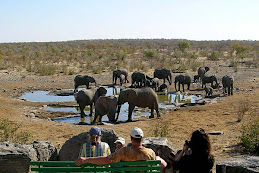The "Big Cat"
Diet - The diet mainly consists of rodents, but they also eat birds, hares, reptiles, frogs and insects.
Colouring - The colouring is very similar to the domestic cat. The back of the ears, however, are orange-pink in colour.
Breeding - The female has a gestation period of 2 months and will then give birth to a litter of between 2 and 5 (mostly 3) kittens.
Size - The African Wild Cat can reach a shoulder height of 35 cm and can weight between 2.5 and 6 kg
The Black-Backed Jackal
Diet - insects, birds, rodents and occasionally small antelope.
Colouring - Light reddish brown. The 'saddle' on its back is black with white speckles. The tail is moderately bushy, fairly long, and sandy, marked with darker hairs, and usually with a dark tip.
Breeding - 1 - 6 (rarely 9) young are born from July - October after a gestation period of about 2 months.
Size - Shoulder height: 30 - 50cm and around 1m long (including a 30cm tail). Black backed jackals weigh up to 12kg
The Damara Dik Dik
Habitat - Dense woodland with thick shrub.
Diet - Because the dik-dik is so small, it needs to eat the most nutritious part of a plant which can include leaves, pods, flowers and occasionally sprouting grass.
Colouring - The back is grey-brown while the neck, shoulders and sides are browner. The chest and underparts are light compared to the rest of the body.
Breeding - The mother gives birth to one young a year after a gestation period of six months.
Size - The shoulder height is an average of 38 cm, wih a weight of 5kg.

